Hey Buddy,
Wanna Get Weighed?
![]()
Hey Buddy,
|
|
by Stephan Wilkinson
This appeared in the September 1998 issue of the Falco Builders Letter and originally appeared in The Aviation Consumer. |
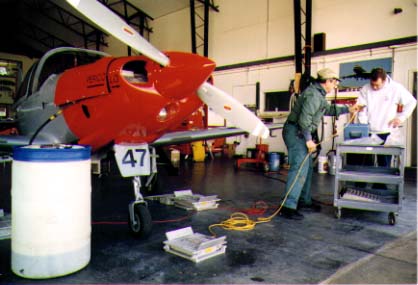
Ed and Michael Reeves set up the scales.
When was the last time your airplane got weighed? Back when Ike was golfing, when it left Lock Haven or Wichita, right? Meanwhile radios have come and gone, engines been overhauled, changed and re-accessorized, seats been replaced-or perhaps removed entirely-and the interior renovated. Perhaps you've had a couple of things 337ed aboard with some quick arithmetic to recalculate weight and balance. Who knows what your airplane really weighs in 1998? Certainly not you.
I didn't know either, it turns out, though my homemade Falco was 'carefully' weighed as recently as 1991, when I finished building it. In time-honored homebuilder manner, I borrowed half a dozen bathroom scales from friends, spanned pairs of them with short planks out on the relatively flat ramp ("gee, that's interesting, look how the numbers fluctuate when the breeze comes up!") and lifted the airplane's three wheels onto the boards: 1,231 pounds. Sounded about right, and I was delighted that I'd done such a good job building it that the airplane came out weighing what the world's more carefully constructed Falcos generally do.
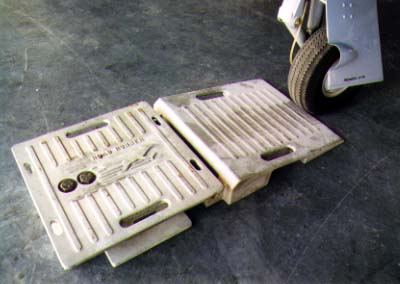
Well, I was 94 pounds low, it turns out, and about an inch too far forward on N747SW's CG. I discovered that last spring by flying the Falco to Reeves Air (401 596-8559), a Westerly, Rhode Island shop that has sophisticated, accurate, biennially recalibrated electronic scales and advertises its aircraft-weighing services. For a flat singles-and-twins fee of $250, Reeves put the Falco inside its hangar sheltered from the wind, totally defueled it, emptied the cockpit of nonessentials, carefully leveled the airplane both laterally and longitudinally (which ultimately involved strapping down the nose gear scissors and partially deflating the nosegear tire-certainly something I'd never considered doing) and used its $5,400 electronic truck scales to come up with a wheel-by-wheel total weight of 1,311 pounds. The entire process took three men about two hours-much of it consumed by laborious defueling and refueling of my nearly full tanks-and left me officially signed off with a computer-generated sheet listing the Falco's new weight and CG and defining the calculations used to compute the CG.
That's a bargain in the airplane world, especially since the job usually takes about an hour longer on a more complex airplane. If I were on the verge of selling my airplane, it would be money well spent as part of the paperwork package with which to reassure a prospective buyer. As it is, I'm confident knowing my airplane's actual to-the-pound weight and, more importantly, its balance.
Oddly enough, homebuilts have no gross-weight limitations. The requirement is simply that the airplane is loaded within its balance envelope and that safe climb performance for the mission being flown is retained. (As a certificated, factory-built Italian design in the 1960s, the Falco had an official maximum gross weight of 1,800 pounds, but homebuilt versions have flown considerably heavier than that. Indeed, the well-known Italian Falco modifier and racer Nustrini once lofted his entire family-four small children, bambino, wife and himself-in the two-seater. Don't believe it? He took an in-flight wide-angle photo to document it, which you can see on the Falco website, www.seqair.com.)
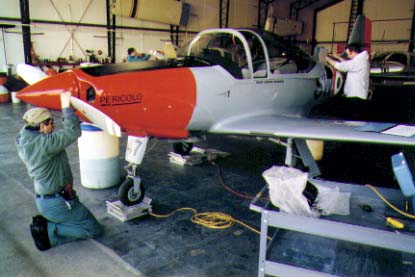
Positioning the Falco on the scales.
Part 135 airplanes require re-weighing every 24 months, but Part 91 operators can get away with having new weights and CGs calculated arithmetically and signed off as a continuing revision of the airplane's original factory empty weight. (You do have to get your airplane reweighed, however, after a major STC installation such as different engine.) And we homebuilders, of course, can for better or worse do it all ourselves from the outset.
To have a professional do the job correctly requires their either defueling the airplane or determining the specific gravity of the fuel aboard. Only then should they do the arithmetic to figure out exactly how much to subtract from the indicated scale weight. Michael Reeves, who with his father, Ed, operates Reeves Air, says, "On something like a Cessna 402 with full tanks, you can be as much as 20 pounds off if you just assume six pounds per gallon and get the specific gravity wrong. Also, who's to say what's 'full tanks'? One guy's full might not be as topped off as another pilot likes them. And with bladder tanks, you can have a wrinkle and not be carrying as much fuel as you think you are."
Planning ahead to arrive for the job with minimal fuel makes sense, particularly if, as in the case of the Falco, the operator uses the airplane's on-board electric fuel pump to empty the tanks, flowing the gasoline into a plastic drum about as fast as a half-open bathroom tap. Even using the quick drains is anything but quick. "The worst was a guy with a 310 who came in from Groton [an 11-nm flight from Westerly] with every tank in that airplane topped-wing tanks, locker tanks, tip tanks-and he'd had the appointment with us for two weeks," Ed Reeves groaned.
Worse yet, Reeves puts the drained fuel back into the tanks by using a small aircraft electric pump driven by an old battery and some jumper cables, the whole horrifying process taking place amid spilled gas and fumes, atop the half-filled fuel barrel. My little wooden airplane never looked so much like a tinderbox. Even an old-fashioned hand-cranked centrifugal pump of the sort my local hardware store uses to dispense kerosene would be far faster and safer, guys.
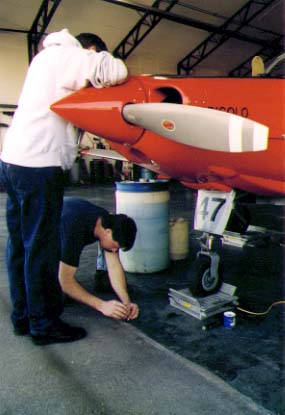
Hanging a plumb line to locate the datum.
Some jobs are a lot bigger than a toothpick homebuilt, of course. One that sticks in Mike Reeves's mind is a Huey: "5,927 pounds empty," he says, consulting his notebook, "and I never want to do that job again." The helo was a bear to jack and level, as was a Cessna 206 on amphibious floats. "It was hard to get four wheels onto three scales-we had to bridge between the two float nosewheels-and it was just a pain working up that high." Though Reeves Air's scales are good for a total of 12,000 pounds, they don't get customers in that empty-weight range because it's uneconomical to take a relatively large Part 135 airplane out of revenue work long enough to fly it to a weighing site. It's cheaper for such an operator to own a set of scales or to deal with somebody who will bring the scales to the customer.
As does Chester, Connecticut weighing specialist Eric Propper (203 269-9634), who flies has scales and equipment hither and yon throughout the Northeast in a Cherokee Six. Propper uses not flatbed scales but highly accurate strain-gauge load cells that fit between an aircraft's jacks and its jacking points, which allows him to relatively easily weigh aircraft as heavy as commuterliners and Gulfstream Ivs. Propper's GA rates run from about $250 to $500, depending on gross weight, plus $75 an hour for the Cherokee time required. Propper is leery of doing homebuilts, however, for many of them don't have well-defined jackpads that can interface with his load cells.
The Reeveses have, of course, seen a variety of object lessons in the efficacy of updating aircraft weights. "One of the worst we ever got was a plain old 172, in fact," says Ed Reeves. "It left the factory 35 years ago, and whenever anybody did any work on it, they apparently just pulled numbers out of the air. The owner brought it to us expecting to gain some useful load, what with the more modern equipment that had been installed over the years, and he ended up losing 70 pounds."
"Worst of all, though, was a Riley Rocket 310 conversion," says son Michael. "Somebody had screwed up the weight and balance after the big engines were installed, and when we redid it, the owner was shocked to discover that he had a six-seat airplane with a 500-pound useful load with full fuel."
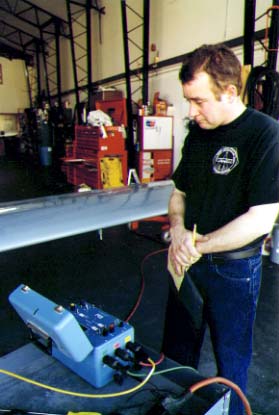
Michael reads the scales.
Another twin that Mike remembers was a Seneca II. "The guy who owned it also had a Seneca III, which of course has 220-horse engines in place of the II's 200s, yet the II supposedly had a higher useful load. It had been reweighed only three years earlier, but near as we could figure, somebody had completely miscalculated the fuel aboard at the time they weighed it. Probably two guys doing the job and failing to communicate with each other."
Mike Reeves considers the salient parts of a good job to be "getting the airplane into a clean, dry hangar and taking your time to level it perfectly, especially longitudinally. Don't ever say 'close enough.' Misleveling won't throw off your empty weight, but it can foul up your CG calculation. Also, getting all the fuel out is important. A lot of people probably think I'm crazy, because they just leave the fuel in and subtract six pounds a gallon. If you do that, at least top it off perfectly and calculate the specific gravity. It may be 5.98 pounds per gallon on that day at that airport in that airplane."
Aircraft weighing isn't a service that every shop provides, but any good local FBO will know the location of the nearest facility with scales. And I highly recommend it as a useful undertaking for EAA chapters hangaring a bunch of airplanes weighed on bathroom scales.